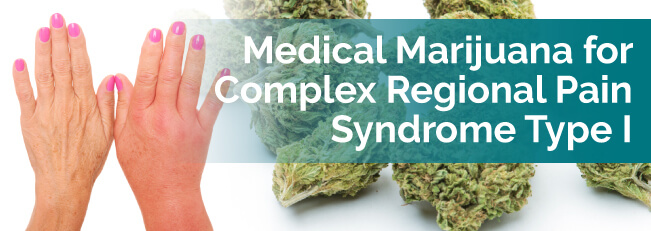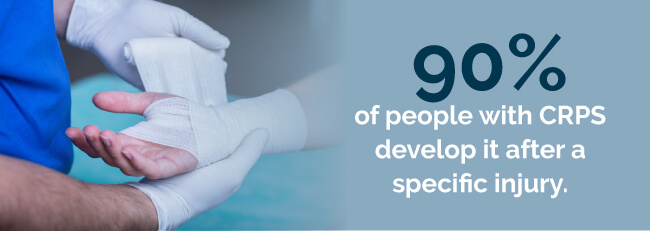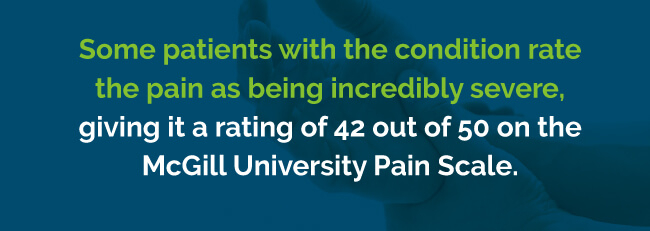
Complex Regional Pain Syndrome Type 1 (CRPS-I), also known as reflex sympathetic dystrophy, is a type of chronic pain syndrome that usually affects one limb, such as an arm or leg. There are two forms of the disease. Type 1 isn’t connected to a specific nerve injury, but can occur after another kind of trauma or injury. People with CRPS-II have had a confirmed injury to a nerve.
In some instances, the symptoms associated with CRPS-I resolve on their own or aren’t very long-lasting. In other cases, the condition progresses, leading to the loss of the use of the affected limb.
Medical marijuana is a recommended alternative mode of treatment for patients suffering from chronic pain due to RSD and CRPD. Patient testimonials have described the immediate relief of cannabidiol treatment as life-saving. Medical marijuana and CRPD treatment can be used to relieve patients of chronic pain, reduce muscle tension and help curb the stress, anxiety and depression associated with this disease.
Find A Doctor Find A Dispensary

One study, published in the Journal of Neurology, Neurosurgery and Psychiatry in 2012, examined the effect marijuana extract pills had on the pain and muscle stiffness patients with CRPS-I experienced. About 29 percent of those who took the cannabis pills had a noticeable reduction in stiffness. Only about 16 percent of those taking the placebo pill reported any reduction in stiffness.
Patients taking pills that contained cannabinoids also had improvements in the pain they felt and a decrease in muscle spasms.
A second study, published in 2013 in the Journal of Pain, examined the effect vaporized cannabis could have on neuropathic pain. Not all the patients in the study had CRPS-I, but all had some type of nerve pain. The patients were divided into three groups and given either a medium dose, low dose or placebo cannabis to “vape.” The patients taking either the medium or low dose cannabis had similar, noticeable levels of pain reduction, with few, if any adverse effects.
Additional studies have suggested that cannabis might be more effective at relieving the pain associated with CRPS-I than opioid medications, including morphine. When the nerves are damaged, the receptors that respond to morphine tend to disappear, making the medication ineffective.
In contrast, cannabinoid receptors remain, even after an injury. Additionally, compared to opioids and morphine, cannabis is relatively inexpensive and has a much lower risk for addiction.
Whether medical marijuana for CRPS-I is an option for you depends on the state you live in. While some states have strict laws that only allow medical cannabis for specific conditions, many other states allow it for unlisted conditions if it has been recommended by a doctor. To find a medical marijuana doctor near you, search our database today.
Looking for more information about CRPS I, CRPS II, Causalgia, or Reflex Sympathetic Dystrophy? Check out our additional resources below:
Find A Doctor Find A Dispensary
Compared to other diseases and conditions, CRPS has had a relatively short history. The first descriptions of it only date back to the 1500s. A French doctor, Ambroise Paré, treated Charles IX of Valois, king of France, for an ongoing pain. The French king developed the pain after bloodletting, a common medical procedure at the time.
Another early description of CRPS dates to the beginning of the 19th century, by a British surgeon named Dr. Denmark. He published a paper about a soldier who had been shot in the upper arm. The bullet passed through the man’s arm completely, and he was able to heal comparatively quickly from that injury. But Denmark noted the patient had developed a burning sensation in the arm, which was enough to cause the soldier to sweat.
Additional reports of a condition resembling CRPS were made around the time of the U.S. Civil War. Dr. Silas Weir Mitchell was a physician treating soldiers who’d been shot. Writing in a book about injuries caused by gunshots, he noted that some patients had a pain that continued, even long after the bullets were taken out.
Mitchell gave the condition the name “causalgia,” which means burning pain. Along with a persistent pain in the area of the original wound, Mitchell noted his patients also typically had shiny, red skin. The appearance of the skin and the burning sensation caused early doctors to compare CRPS to frostbite.
During the 20th century, doctors began to realize the symptoms patients were experiencing were in some way connected to the sympathetic nervous system. That led some doctors to attempt to treat the condition by performing a sympathectomy, or surgical removal of the affected nerve.
In the 1940s, Dr. James Evans, a physician working in Massachusetts, called the condition reflex sympathetic dystrophy, or RSD. He suggested using nerve blocks to ease the pain in patients.
During the earliest history of RSD or CRPS, doctors mainly looked at it as a condition that occurred after an injury. It wasn’t until a conference that took place in Orlando, Fla., in 1993 that doctors decided to separate the disease into the two types.
It’s not only the cause of the pain that differs between Types I and II. The way the pain feels is also somewhat different. While people with CRPS-II often experience neuropathic pain, people with Type I commonly experience pain caused by stimulation of the nerves.
Patients with Type II usually have an observable form of injury or damage to the nerves, while patients with Type I typically have no visible nerve damage.
CRPS-I is the more common of the two types of CRPS. About 90 percent of people with CRPS develop it after a specific injury.

Some injuries that are commonly linked to CRPS include:
No matter what the source of the injury is, people who end up developing CRPS-I typically have an abnormal or excessive response to the pain trigger. In fact, some people with CRPS may also have abnormalities of their peripheral nerves that make it more difficult for those nerves to communicate after an injury.
A person doesn’t need to have experienced an injury to develop CRPS-I, though those cases are the rarest. In those instances, the condition could be connected to an infection or an issue going on inside of the body.
It’s also possible that the cause of CRPS-I is in some way connected to a heightened response of the immune system. Just as allergy sufferers’ immune systems overreact to harmless substances, people with CRPS produce higher levels of cytokines, or inflammatory chemicals, than others. The increased levels of cytokines could be responsible for the skin changes many people with CRPS-I experience. Additionally, CRPS-I is fairly common in people who also have allergies and other autoimmune disorders.
Another possible cause of CRPS-I could have something to do with genes or family history. Although it’s rather rare, there have been instances of the syndrome running in families. Cases of CRPS-I that do have a genetic connection are often more severe and tend to develop earlier in a person’s life.
Any person can develop CRPS-I, but there are some groups of people who have an increased risk for the condition. For example, the syndrome can occur in children, but the National Institute of Neurological Disorders and Stroke points out that it is very rare in children under the age of 10 and virtually unheard of in children under age 5.
The group most likely to be diagnosed with the syndrome are women, usually those between the ages of 40 and 50. The condition tends to be very rare in older people.
Because of confusion about the symptoms of CRPS and the various names the illness has had over the years, it’s hard to pin down an exact number of individuals who have the condition, at least in the U.S. The disease is classified as a rare condition, which means that there are fewer than 200,000 cases of it in the U.S.
CRPS-I has signs of persistent, chronic pain, allodynia and hyperalgesia with disproportionate levels of pain. Type I RSD can progress into a means of immobilization. Additionally, Type I can be identified by the changes in skin color due to fluctuations of blood flow. This condition is easily misdiagnosed as a nerve injury.

Pain is perhaps the most notable symptom of CRPS-I. Some patients with the condition rate the pain as being incredibly severe, giving it a rating of 42 out of 50 on the McGill University Pain Scale. The pain needs to be persistent and ongoing, usually lasting for at least six months. Often, the pain is described as throbbing or burning.
While pain is the most common symptom, it’s not the only one. Other possible symptoms of CRPS-I include:
In some cases, stress can make the symptoms of CRPS-I worse. While some people notice that their symptoms clear up or resolve on their own, the condition can persist for years in others.
The symptoms associated with CRPS-I usually don’t occur all at once. The condition is divided into separate stages. During the earliest stages, you have the greatest chance for a full recovery. Treating or curing the condition becomes more difficult, if not impossible, as it progresses.
Stage 1 usually lasts from anywhere from one month to three months, although it’s also possible for patients never to advance out of stage 1. During stage 1, you might notice that your hair and nails grow faster than before, that the skin feels warm or cold and that it’s more sensitive to touch.
It’s also common to have swelling, a good deal of pain, stiffness in the joints and some changes to the bone. Some visible skin changes can also occur during this stage. Many patients in stage 1 feel as if the affected limb is burning up, only to find that it feels cool when they touch it.
Stage 2 usually starts about three months into the disease and can continue for another three months. Patients in stage 2 experience pain as they did during stage 1, and are likely to have swelling, changes in skin color and skin that feels cool.
While nails grew faster in stage 1, they are likely to become brittle and uneven in stage 2. Hair growth might also slow down. The pain a person feels usually also becomes worse during stage 2.
Stage 2 is also known as the dystrophic stage, as certain functions start to break down. For example, patients can begin to experience muscle loss and weakness, as well as some memory problems and difficulty concentrating. In some instances, osteoporosis can also develop in the bones during this stage.
Once a patient moves onto stage 3, or the atrophic stage, the changes caused by CRPS-I are typically irreversible. Pain might be persistent and throughout the entire limb during this stage. There is also significant muscle wasting, as well as damage to the ligaments, which makes movement difficult.
People in stage 3 might also have signs of depression and anxiety, due to the severe pain they live with.
During stages 1 and 2, it is possible for CRPS-I to improve with a variety of treatments. Some forms of therapy or treatment help slow the progression of the disease, while others help relieve the immediate symptoms a patient might be feeling. It’s common for a doctor to recommend a variety of treatments to help patients. They might include:
Therapy to treat CRPS-I can include physical therapy to strengthen the limb and help a patient retain the ability to move. In some cases, psychotherapy can help a patient cope with any feelings of depression or anxiety that might accompany the diagnosis or symptoms. During psychotherapy, your therapist can help you learn to cope with the symptoms of the disease, and can also help you prepare for any progression of symptoms.
Usually, physical therapy is most effective when a patient starts it early in the course of the disease.
A variety of medicines is available to help ease the symptoms associated with CRPS-I or to help relieve pain. It’s worth noting that no one single drug is specifically approved by the FDA for the treatment of the condition. Additionally, many drugs have a considerable number of side effects or adverse effects, especially if they are used for a long time.

Some of the medicines your doctor might prescribe to treat CRPS-I include:
Surgery to treat CRPS-I is controversial because it might not improve symptoms. One operation that can be performed is sympathectomy, which removes the nerves that might be responsible for the pain. The major drawback of this procedure is that it doesn’t always work. In some instances, it can even make your symptoms worse.


Please allow us to access your location to find local dispensaries.
VIEW ALL DISPENSARIES ➔